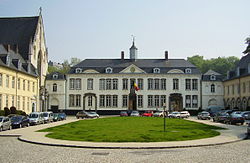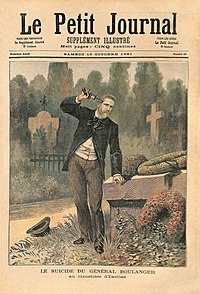Ixelles
This article needs additional citations for verification. (November 2010) |
Ixelles
| |
|---|---|
 La Cambre Abbey in Ixelles. | |
| Coordinates: 50°50′N 04°22′E / 50.833°N 4.367°E | |
| Country | |
| Community | Flemish Community French Community |
| Region | Brussels-Capital |
| Arrondissement | Brussels |
| Government | |
| • Mayor | Dominique Dufourny (MR) |
| • Governing party/ies | MR, PS, sp.a |
| Area | |
| • Total | 6.41 km2 (2.47 sq mi) |
| Population (2020-01-01)[1] | |
| • Total | 87,632 |
| • Density | 14,000/km2 (35,000/sq mi) |
| Postal codes | 1050 |
| NIS code | 21009 |
| Area codes | 02 |
| Website | www.ixelles.be |
Ixelles (French pronunciation: [iksɛl]; Dutch: Elsene pronounced [ˈɛlsənə] ) is one of the nineteen municipalities located in the Brussels-Capital Region of Belgium. In common with all the Brussels municipalities, it is legally bilingual.
Ixelles is located in the suburbs towards the south of Brussels' city center and is geographically bisected by the City of Brussels municipality. It is generally considered an affluent area of the city[2] and is particularly noted for its communities of European and Congolese immigrants.[2]
Geography

Elsene/Ixelles is located in the south of Brussels and is divided into two parts by Louisalaan / Avenue Louise, which is part of the City of Brussels municipality. The smaller west part of the municipality includes Baljuwstraat/Rue du Bailli and extends roughly from Louisalaan/Avenue Louise to Brugmannlaan/Avenue Brugmann.
The larger east part of the municipality includes the campuses of Brussels' two leading universities, the Francophone Université Libre de Bruxelles and the Dutch-speaking Vrije Universiteit Brussel, along with the Place Eugène Flagey/Flageyplein. The Ter Kamerenbos/Bois de la Cambre is located just south of Elsene/Ixelles.
The construction of Louisalaan/Avenue Louise was commissioned in 1847 as a monumental avenue bordered by chestnut trees that would allow easy access to the popular recreational area of the Ter Kamerenbos/Bois de la Cambre. It was also to be the first Haussmann-esque artery of the city of Brussels. However, fierce resistance to the project was put up by the town of Elsene/Ixelles (which was then still separate from Brussels) through whose land the avenue was supposed to run. After years of fruitless negotiations, Brussels finally annexed the narrow band of land needed for the avenue plus the Ter Kamerenbos/Bois de la Cambre itself in 1864. That decision accounts for the unusual shape of today's City of Brussels and for Elsene/Ixelles being split in two separate parts.
History
Medieval origins


The placename was first mentioned in 1210 as Elsela, from Old Dutch Else(n)lo meaning alder woods.[3] The origins of the village date from the foundation of the Abbey of La Cambre by a Benedictine nun in 1196. The abbey was located near the springs of the Maelbeek in the Sonian Forest, the remnant of which closest to Brussels became known as Bois de la Cambre. The abbey was consecrated by the Bishop of Cambrai soon after its foundation. Boniface of Brussels and Alice of Schaerbeek were two of its most famous residents in the 13th century.
Around 1300, during the reign of John II, Duke of Brabant, a hostel was built near the abbey to provide meals to the wood bearers working in the forest. Soon, a hamlet and a couple of chapels were built, including the Church of the Holy Cross (French: Sainte Croix, Dutch: Heilige Kruis), also dedicated by the Bishop of Cambrai in 1459. The area included several ponds, still visible today, that provided fish to the abbey and to the neighbouring hamlets. At that time, part of Ixelles was a dependence of Brussels; the other part was the property of the local lord.
Before the Revolution
In 1478, the wars between Louis XI of France and Maximilian I, Holy Roman Emperor brought devastation to the abbey and the surrounding areas. In 1585, the Spanish burnt down most of the buildings to prevent them from being used as a refuge by the Calvinists. The abbey was restored in time for the Joyous Entry of the Archdukes Albert and Isabella in 1599. Further manors and castles (Ermitage, Ten Bosch, Ixelles) were built in Ixelles in the 16th century, gradually transforming the hamlet into a full-fledged village. The purity of the pond water attracted breweries to the area, some of which survived well into the 20th century.
Independent municipality

In 1795, like many of the other towns surrounding Brussels, Ixelles was proclaimed a separate municipality by the French regime after the Revolution. The abbey was stripped of its religious functions, becoming among others a cotton-manufacturing plant, a farm, a military school, and a hospital. Many of the medieval gates of Brussels that lined what is now the inner ring road were taken down and more streets were built to accommodate the migration towards the suburbs. Ixelles' population grew nearly one-hundredfold, from 677 in 1813 to more than 58,000 in 1900.[citation needed]
At the end of the 19th century, some of the ponds were drained, leaving only the so-called "Ixelles Ponds", and a new Church of the Holy Cross was built. The first streetcars appeared in 1884 and the first movie theatre in 1919. Ixelles and the Avenue Louise became one of the classy areas of Brussels. Artists and celebrities moved in, leading to architectural novelties such as Art Nouveau and Art Deco.
Economy
The company Solvay has its head office in Ixelles.[4] Aiplex Software maintains its Belgium office in Ixelles.[5]
Matongé
Ixelles is known throughout Belgium for its large community of people of African origin. This population is mainly concentrated near the Porte de Namur, and is known as Matongé or Matongué after the marketplace and the commercial district with the same name in Kalamu, Kinshasa. The core of Matongé was formed in late 1950s by the foundation of Maisaf (an abbreviation of Maison Africaine or "African House") which served as a centre and residence for university students from the Belgian Congo. After Congolese independence in 1960, the district faced an influx of immigrants from the new state who shaped the neighbourhood in a style to resemble the original Matongé. During the sixties and into the seventies the area was a well known meeting place for students and diplomats from the Zaire. At the time they were known locally as "Belgicains".[citation needed] There are also communities from other African countries like Rwanda, Burundi, Mali, Cameroon, and Senegal present in the district.
The famous shopping arcades, the Galerie d'Ixelles and the Galerie de la Porte de Namur are both located in the heart of Matongé. In the gallery and the adjoining streets you can find a large number of specialised food shops and suppliers. The area is renowned for its clothes, shoes and material shops, hairdressers and wigmakers, booksellers, jewellers and craft shops, making the area unmissable for many local and even international visitors, men and women, young and older. Over 45 different nationalities amongst the residents and shopkeepers can be counted including most African countries. Statistically, many of the shopkeepers are not necessarily local residents. Amongst the visitors and window shoppers to Matongé are many who appreciate African fashion and the life-style.
The district also attained notoriety from the early 2000s with gang violence perpetrated by African gangs, partly composed of exiled child soldiers like Black Démolition. It was the scene of race riots in January 2001. Matongé, with its more recent immigrant communities from Latin America, Pakistan, and India along with African ones, is seen as a symbol of multiculturalism in Belgium. The local authorities, community groups and residents with a certain degree of success have more recently re-established the area as a safe place to visit. As the area and property ages there is increased pressure and interest from property developers to expand the European Quarter on one side and the fashionable Avenue Louise on the other, effectively Matongé is sandwiched between the two.
Every year since 2001 at the end of June, a successful multi-cultural festival, "Matonge en Couleurs", has been organised in the area. The date coincides with the celebration of Congolese independence. The film Juju Factory, released in 2006 was partly filmed in the area. The local television channel Télé Bruxelles broadcasts a weekly magazine programme, Téle Matongé XL.
The pedestrian street rue Longue-Vie is full of snack-bars where African food is sold. Most of these have been decorated by the famous afro-European artist John Bush. Le Soleil d'Afrique has almost become his museum, with not only his original paintings on display, but also other painted surfaces and furniture.
Main sights

- The buildings of the Abbaye de la Cambre house a renowned school for the visual arts, the National Geographic Institute, and various parish functions.
- The Ixelles Ponds and Tenbosch Park are noted parks in the middle of the city.
- The Art Deco building on the Flagey square used to house the studios of the Belgian radio and television broadcasting companies (RTBF and VRT). The Résidence de la Cambre is another notable Art Deco building.
- Several Art Nouveau houses built by Victor Horta are listed as a UNESCO world heritage site, and some of them can be visited.
- Two universities—the Université Libre de Bruxelles and the Vrije Universiteit Brussel—have their campuses in Ixelles. As a result, the southeast part of the municipality is home to a large number of students.
- The Ixelles Cemetery is one of the most important cemeteries in the country as it contains the graves of a number of famous Belgian personalities. It was there, in 1891, that the French General Georges Boulanger, leader of the right-wing Boulangerists, committed suicide, on the tomb of his mistress, who had died a couple of months earlier.
- Ixelles also houses several interesting churches and museums, including a fine-arts museum and the Constantin Meunier museum established in the residence where the artist lived part of his life.
Events
Several fairs are organized in Ixelles, including the Spring Fair on the Flagey square, which takes place between the fourth and sixth Sunday after Easter, and the Boondael Fair at the end of July.
International relations
Twin towns – sister cities
Ixelles is twinned with, in chronological order:
 Biarritz, France (since 1958)[6]
Biarritz, France (since 1958)[6] Kalamu commune in Kinshasa, Democratic Republic of the Congo (since 2003)[7]
Kalamu commune in Kinshasa, Democratic Republic of the Congo (since 2003)[7] Zababdeh, West Bank (since 2003)[7][8]
Zababdeh, West Bank (since 2003)[7][8] Kibbutz Megiddo, Israel (since 2012)[7]
Kibbutz Megiddo, Israel (since 2012)[7]
Notable people
Born in Ixelles (sorted by first name):
- Agnes Varda, film director (b. 1928)
- Albert Crahay, (1903-1991), soldier and commander of the Belgian battalion at the Battle of the Imjin River during the Korean War
- Annemie Neyts (1944), politician, MEP
- Anna Boch (1848-1936), Impressionist painter, art collector significant (as Vincent Van Gogh)
- Audrey Hepburn, actress, fashion model, and humanitarian (1929–1993), Kayenveld street, N°48

- Auguste Perret, architect (1874–1954)
- Boris Szulzinger (b. 1945), film director and producer
- Camille Lemonnier, writer and poet (1844–1913)
- Emile Vandervelde, statesman (1866–1938)
- Michel Regnier, also known as Greg, comic-book writer and artist (1931–1999)
- Jaco Van Dormael, screenwriter and film director (b. 1957)
- Jacques Feyder, screenwriter and film director (1885–1948)
- Jean-François van Boxmeer (b. 1961), manager
- Jules de Burlet (1844-1897), prime minister
- Julio Cortázar, writer of novels (1914–1984)
- Kris Bosmans (b. 1980), cyclist
- Leo Joseph Suenens, cardinal of the Roman Catholic Church (1904–1996)
- Marc Dutroux, (b. 1956), serial killer and child molester
- Marc Moulin (1942-2008), jazz and fusion musicians, author
- Michel de Ghelderode, avant-garde dramatist (1898–1962)
- Natacha Régnier, actress (b. 1974)
- Paul Hymans, politician and former president of the League of Nations (1865–1941)
- Paul Saintenoy, architect, teacher, architectural historian, and writer (1862–1952)
- Pierre Kolp, composer (b. 1969)
- Pierre Rapsat (1948-2002), singer
- Ursula von der Leyen, German Federal Minister for Labor and Social Affairs (b. 1958)
- Yannick Ferreira Carrasco, footballer (b. 1993)
Lived in Ixelles:
- Anna Boch, artist and art collector, owner of the Villa Anna (1848–1936)
- Antoine Wiertz, painter and sculptor (1806–1865)
- August de Boeck, composer, organist, and music pedagogue (1865–1937)
- Auguste Rodin, sculptor (1840–1917)
- Charles de Coster, novelist (1827–1879)
- Constantin Meunier, painter and sculptor (1831–1905)

- Edith Cavell (1865–1915) British nurse and World War I martyr ran a nursing school here from 1907
- Elisée Reclus, geographer and anarchist (1830–1905)
- Ernest Solvay, chemist, industrialist, and philanthropist (1838–1922)
- Giacomo Puccini, composer (1858–1924); lived and died at nr 1, avenue de la Couronne; a tablet with an inscription is visible on the building wall
- Henriëtte Ronner-Knip, painter (1821–1909)
- Jean-Baptiste Moens, philatelist and stamp dealer (1833–1908)
- Johan Michiel Dautzenberg, writer, (1834–1878)
- Karl Marx, philosopher, political economist, and socialist revolutionary (1818–1883)[9]
- Maria Malibran, mezzo-soprano (1808–1836)
- Neel Doff, writer (1858–1942)
- Octave Maus, art critic, writer, and lawyer (1856–1919)
- Pierre-Joseph Proudhon, anarchist thinker (1809–1865)
- Vladimir Lenin, Russian revolutionary and first head of the Soviet Union (1870–1924)
See also
References
- ^ "Bevolking per gemeente op 1 januari 2020". Statbel.
- ^ a b "Ixelles and St Gilles". Areas in Brussels. Wanted in Europe: Brussels. Retrieved 16 June 2013.
- ^ Jan de Vries, Woordenboek der Noord- en Zuidnederlandse plaatsnamen, Het Spectrum publishers, 1962
- ^ "Solvay Headquarters access map." Solvay. Retrieved on 5 July 2011. "Rue du Prince Albert, 33 – 1050 Ixelles"
- ^ "Contact Us." Aiplex Software. Retrieved on 18 September 2012. "12A. av du Derby, 1050 Brussels, Belgium."
- ^ "Twin towns, Biarritz official website". Biarritz.fr. Retrieved 11 May 2013.
- ^ a b c "Jumelages et coopération internationale". Ixelles.be. Retrieved 25 August 2016.
- ^ "Welcome to Zababdeh". Ixelles.be. Retrieved 8 November 2013.
- ^ http://www.brusselsremembers.com/memorials/karl-marx






